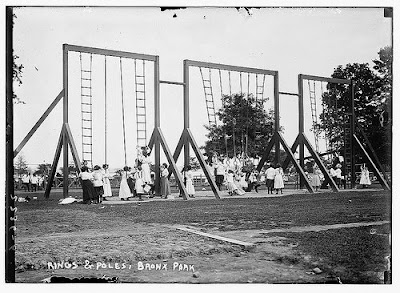
A more modern take on hangouts is this teen playscape designed for Villiers High School in West London by a Royal College of Art student. Villiers students themselves initiated the design process for an eco-playground aimed at teenagers.
"They applied for funding and when they discovered no specialist playground company could provide what they wanted, they turned...to RCA design students for help. The result was a design commission for Clara Gaggero (IDE graduate 2007). Now a well used, much appreciated school facility, the project was unique in that all the pupils of the school were consulted over the plans, with workshops run, films and presentations made and the playground built to the pupils’ specifications."
"The school had been having problems with the existing playground, because it seemed to be a focus for aggression and violence, with some students even having their noses broken. In fact, at lunchtime the space was only used by 30 or 40 students, with the rest choosing to stay indoors. The school obtained funding of £25,000 to redesign the playground, and because it had been impressed with Clara’s previous work, in particular her willingness to consult the students themselves, it invited her back.
The school had already been approached by makers of playground equipment, who had wanted to install slides and swings, which clearly would have been inappropriate for teenagers. Clara, by contrast, ran three workshops with students to find out what they wanted, which was a space in which they could socialise freely. The teachers, meanwhile, were keen for her to create a space that would minimise playtime fighting.
With the students’ help, Clara came up with a design that breaks up the playground area using lots of large concrete blocks. Two moulds were used to create the blocks: one in the shape of a bench, and the other a box with two sides missing. Altogether, they created 35 precast benches and 25 precast boxes. By putting the blocks next to each other, or putting one on top of the other, Clara created different kinds of spaces where students could stand, sit or climb. The blocks were painted a bright green.
The idea was to create territories in the playground, where teenagers could socialise with their own circle of friends. “The less prescriptive the spaces, the more people will find a corner,” says Clara. “In this case, their way to play is socialising – they are in that stage where you hang around and talk, so it just needed a lot of spots to chat.” Since the blocks were installed in May, the playground has been used much more extensively. Now, at lunchtimes, there are about 700 students using the space: “They found their own area – people who were a bit more extrovert were always in the centre of the playground and people who were a bit more shy were always on the borders.” What is more, Clara adds, the sense of danger in the playground has disappeared: “Since May there have been no broken noses.”
Here's what she says about the project, entitled Platforum:
"numbers that explain this adventure: 1,300 students 35 nationalities 1,750 sqm to refurbish £15 budget per sqm 3 days to meet the students 6 days to generate 3 concepts 24 days to finalise and produce the chosen design 12 days to build it 1,200 sqm of new asphalt 300 sqm of green paint 40 m of climbing wall3 5 concrete precast benches 25 concrete precast boxes4 moulds 1 crane 3 lorries 4.22 GB of files 3 teachers 14 students 7 friends 4 mentors 16 builders 3 contractors… 5 photos by Adrian Westaway"


















